Molecular Basis for the Selectivity of DHA and EPA in Sudlow’s Drug Binding Sites in Human Serum Albumin with the Combined Use of NMR and Docking Calculations
Abstract
1. Introduction
2. Results and Discussion
2.1. STD and INPHARMA NMR Competition Experiments on DHA and EPA with Warfarin and Ibuprofen
2.1.1. The Binding Site FA7
2.1.2. The Binding Site FA4
2.2. Docking Calculations
2.2.1. The Binding Site FA7
2.2.2. The Binding Site FA4
2.2.3. The Binding Site FA3
2.2.4. The Binding Site FA6
3. Materials
4. NMR Experimental Procedures
5. Computational Methods
6. Conclusions
- (a)
- The INPHARMA technique demonstrated the advantage, compared to STD and its variants, of showing numerous strong interligand NOE connectivities between warfarin and DHA/EPA, indicating that both ligands share a common FA7 binding site with distances <5 Å and, thus, are competitive rather than allosteric. The interligand NOEs and docking calculations showed the presence of two conformational states of DHA/EPA due to the presence of two anchoring polar groups of amino acids. DHA and EPA adopt highly folded conformations in the polyunsaturated moiety. Therefore, the exceptional flexibility of the polyunsaturated chain of DHA and EPA is the key property for interactions within the FA7 binding pocket;
- (b)
- In the binding site FA4, the interligand NOEs and docking calculations demonstrated the presence of two anchor sites, in agreement with the FFAs of up to C-18 atoms;
- (c)
- DHA and EPA possess higher FA3 and FA4 affinities with respect to FFAs with shorter chains and PUFAs with smaller numbers of double bonds. The latter finding is entirely consistent with experimental results obtained by employing the fluorescent probe ADIFAB [20];
- (d)
- The approach employing site-specific molecular docking driven by X-ray crystallography and NMR measurements was highly successful in describing the interactions of PUFAs with long chains, since it could minimize known irreproducibility problems in biomedical research [49];
- (e)
- The HSA protein has the ability, through its amino acid sequence, to adopt a multidomain tertiary structure and generate corresponding interactions depending on the size of the molecule. The above property of the protein makes it capable of capturing a wide variety of molecules and playing a pivotal role in health and disease as a carrier of drugs, nutrients, or toxic molecules [12,13,14,15,16,17,18,19].
Supplementary Materials
Author Contributions
Funding
Institutional Review Board Statement
Informed Consent Statement
Data Availability Statement
Conflicts of Interest
Sample Availability
References
- Vance, D.E.; Vance, J.E. Biochemistry of Lipids, Lipoproteins, and Membranes, 5th ed.; Elsevier: Amsterdam, The Netherlands, 2008. [Google Scholar]
- Akoh, C.C.; Min, D.B. Food Lipids, Chemistry, Nutrition and Biochemistry, 1st ed.; Marcel Dekker Inc.: New York, NY, USA, 2002. [Google Scholar]
- Leray, C. Dietary Lipids for Healthy Brain Function; CRC Press: Boca Ratan, FL, USA, 2017. [Google Scholar]
- Alexandri, E.; Ahmed, R.; Siddiqui, H.; Choudhary, M.I.; Tsiafoulis, C.G.; Gerothanassis, I.P. High resolution NMR spectroscopy as a structural and analytical tool for unsaturated lipids in solution. Molecules 2017, 22, 1663. [Google Scholar] [CrossRef]
- Stillwell, W.; Wassall, S.R. Docosahexaenoic acid: Membrane properties of a unique fatty acid. Chem. Phys. Lipids 2003, 126, 1–27. [Google Scholar] [CrossRef] [PubMed]
- Hishikawa, D.; Valentine, W.J.; Iizuka-Hishikawa, Y.; Shindou, H.; Shimizu, T. Metabolism and functions of docosahexaenoic acid-containing membrane glycerophospholipids. FEBS Lett. 2017, 591, 2730–2744. [Google Scholar] [CrossRef]
- De Urquiza, A.M.; Liu, S.; Sjöberg, M.; Zetterström, R.H.; Griffiths, W.; Sjovall, J.; Perlmann, T. Docosahexaenoic acid, a ligand for the retinoid X receptor in mouse brain. Science 2000, 290, 2140–2144. [Google Scholar] [CrossRef] [PubMed]
- Balendiran, G.K.; Schnütgen, F.; Scapin, G.; Börchers, T.; Xhong, N.; Lim, K.; Godbout, R.; Spener, F.; Sacchettini, J.C. Crystal structure and thermodynamic analysis of human brain fatty acid-binding protein. J. Biol. Chem. 2000, 275, 27045–27054. [Google Scholar] [CrossRef]
- Rademacher, M.; Zimmerman, A.W.; Rüterjans, H.; Veerkamp, J.H.; Lücke, C. Solution structure of fatty acid-binding protein from human brain. Mol. Cell Biochem. 2002, 239, 61–68. [Google Scholar] [CrossRef]
- Goc, A.; Niedzwiecki, A.; Rath, M. Polyunsaturated ω-3 fatty acids inhibit ACE2-controlled SARS-CoV-2 binding and cellular entry. Sci. Rep. 2021, 11, 5207. [Google Scholar] [CrossRef]
- Hodgson, J. All about Albumin: Biochemistry, Genetics and Medical Applications; Academic Press: San Diego, CA, USA, 2001. [Google Scholar]
- Wenskowsky, L.; Wagner, M.; Reusch, J.; Schreuder, H.; Matter, H.; Opatz, T.; Petry, M.S. Resolving binding events on the multifunctional human serum albumin. Chem. Med. Chem. 2020, 15, 738–743. [Google Scholar] [CrossRef]
- Mishra, V.; Heath, R.J. Structural and biochemical features of human serum albumin essential for eukaryotic cell culture. Int. J. Mol. Sci. 2021, 22, 8411. [Google Scholar] [CrossRef] [PubMed]
- Di Massi, A. Human serum albumin: From molecular aspects to biotechnological applications. Int. J. Mol. Sci. 2023, 24, 4081. [Google Scholar] [CrossRef]
- Merlino, A. Metallodrug binding to serum albumin: Lessons from biophysical and structural studies. Coord. Chem. Rev. 2023, 480, 215026. [Google Scholar] [CrossRef]
- Petitpas, I.; Bhattacharya, A.A.; Twine, S.; East, M.; Curry, S. Crystal structure analysis of warfarin binding to human serum albumin anatomy of drug site I. J. Biol. Chem. 2001, 276, 22804–22809. [Google Scholar] [CrossRef]
- Ghuman, J.; Zunszain, P.A.; Petitpas, I.; Bhattacharya, A.A.; Otagiri, M.; Curry, S. Structural basis of the drug-binding specificity of human serum albumin. J. Mol. Biol. 2005, 353, 38–52. [Google Scholar] [CrossRef] [PubMed]
- Fasano, M.; Curry, S.; Terreno, E.; Galliano, M.; Fanali, G.; Narciso, P.; Notari, S.; Ascenzi, P. The extraordinary ligand binding properties of human serum albumin. IUBMB Life 2005, 57, 787–796. [Google Scholar] [CrossRef]
- Fanali, G.; di Masi, A.; Trezza, V.; Marino, M.; Fasano, M.; Ascenzi, P. Human serum albumin: From bench to bedside. Mol. Asp. Med. 2012, 33, 209–290. [Google Scholar] [CrossRef] [PubMed]
- Richieri, G.V.; Anel, A.; Kleinfeld, A.M. Interactions of long-chain fatty acids and albumin: Determination of free fatty acid levels using the fluorescent probe ADIFAB. Biochemistry 1993, 32, 7574–7580. [Google Scholar] [CrossRef]
- Curry, S.; Brick, P.; Franks, N.P. Fatty acid binding to human serum albumin: New insights from crystallographic studies. Biochim. Biophys. Acta 1999, 1441, 131–140. [Google Scholar] [CrossRef]
- Bhattacharya, A.A.; Grűne, T.; Curry, S. Crystallographic analysis reveals common modes of binding of medium and long-chain fatty acids to human serum albumin. J. Mol. Biol. 2000, 303, 721–732. [Google Scholar] [CrossRef] [PubMed]
- Petitpas, I.; Grűne, T.; Bhattacharya, A.A.; Curry, S. Crystal structures of human serum albumin complexed with monounsaturated and polyunsaturated fatty acids. J. Mol. Biol. 2001, 314, 955–960. [Google Scholar] [CrossRef]
- Simard, J.R.; Zunszain, P.A.; Ha, C.E.; Yang, J.S.; Bhagavan, H.V.; Petitpas, I.; Curry, S.; Hamilton, J.A. Locating high-affinity fatty acid-binding sites of albumin by X-ray crystallography and NMR spectroscopy. Proc. Natl. Acad. Sci. USA 2005, 102, 17958–17963. [Google Scholar] [CrossRef] [PubMed]
- Krenzel, E.S.; Chen, Z.; Hamilton, J.A. Correspondence of fatty acid and drug binding sites on human serum albumin: A two-dimensional nuclear magnetic resonance study. Biochemistry 2013, 52, 1559–1567. [Google Scholar] [CrossRef] [PubMed]
- Hernychova, L.; Alexandri, E.; Tzakos, A.G.; Zatloukalova, M.; Primikyri, A.; Gerothanassis, I.P.; Uhrik, L.; Šebela, M.; Kopečný, D.; Jedinák, L.; et al. Serum albumin as a primary non-covalent binding protein for nitro-oleic acid. Int. J. Biol. Macromol. 2022, 203, 116–129. [Google Scholar] [CrossRef] [PubMed]
- Alexandri, Ε.; Primikyri, A.; Papamokos, G.; Venianakis, T.; Gkalpinos, V.G.; Tzakos, A.G.; Karydis-Messinis, A.; Moschovas, D.; Avgeropoulos, A.; Gerothanassis, I.P. NMR and computational studies reveal novel aspects in molecular recognition of unsaturated fatty acids with non-labeled serum albumin. FEBS J. 2022, 289, 5617–5636. [Google Scholar] [CrossRef] [PubMed]
- Claasen, B.; Axmann, M.; Meinecke, R.; Meyer, B. Direct observation of ligand binding to membrane proteins in living cells by a saturation transfer double difference (STDD) NMR spectroscopy method shows a significantly higher affinity of integrin alpha(IIb)beta3 in native platelets than in liposomes. J. Am. Chem. Soc. 2005, 127, 916–919. [Google Scholar] [CrossRef]
- Monaco, S.; Tailford, L.E.; Juge, N.; Angulo, J. Differential epitope mapping by STD NMR spectroscopy to reveal the nature of protein-ligand contacts. Angew. Chem. Int. Ed. 2017, 56, 15289–15293. [Google Scholar] [CrossRef]
- Monaco, S.; Ramírez-Cárdenas, J.; Carmona, A.T.; Robina, I.; Angulo, J. Inter-ligand STD NMR: An efficient 1D NMR approach to probe relative orientation of ligands in a multi-subsite protein binding pocket. Pharmaceuticals 2022, 15, 1030. [Google Scholar] [CrossRef]
- Potenza, D.; Vasile, F.; Belvisi, L.; Civera, M.; Araldi, E.M. STD and tr-NOESY NMR study of receptor-ligand interactions in living cancer cells. Chem. Bio. Chem. 2011, 12, 695–699. [Google Scholar] [CrossRef] [PubMed]
- Mari, S.; Invernizzi, C.; Spitaleri, A.; Alberici, L.; Ghitti, M.; Bordignon, C.; Traversari, C.; Rizzardi, G.-P.; Musco, G. 2D Tr-NOESY experiments interrogate and rank ligand-receptor interactions in living human cancer cells. Angew. Chem. Int. Ed. 2010, 49, 1071–1074. [Google Scholar] [CrossRef]
- Primikyri, A.; Sayyad, N.; Quilici, G.; Vrettos, E.I.; Lim, K.; Chi, S.-W.; Musco, G.; Gerothanassis, I.P.; Tzakos, A.G. Probing the interaction of a quercetin bioconjugate with Bcl-2 in living human cancer cells with in-cell NMR spectroscopy. FEBS Lett. 2018, 592, 3367–3379. [Google Scholar] [CrossRef] [PubMed]
- Sanchez-Pedregal, V.M.; Reese, M.; Meiler, J.; Bloomers, M.J.J.; Griesinger, C.; Carlomagno, T. The INPHARMA method: Protein-mediated interligand NOEs for pharmacophore mapping. Angew. Chem. Int. Ed. 2005, 44, 4172–4175. [Google Scholar] [CrossRef] [PubMed]
- Carlomagno, T. NMR in natural products: Understanding conformation, configuration and receptor interactions. Nat. Prod. Rep. 2012, 29, 536–554. [Google Scholar] [CrossRef]
- Primikyri, A.; Papamokos, G.; Venianakis, T.; Sakka, M.; Kontogianni, V.; Gerothanassis, I.P. Structural basis of artemisinin binding sites in serum albumin with the combined use of NMR and docking calculations. Molecules 2022, 27, 5912. [Google Scholar] [CrossRef] [PubMed]
- Kitchen, D.B.; Decornez, H.; Furr, J.R.; Bajorath, J. Docking and scoring in virtual screening for drug discovery: Methods and applications. Nat. Rev. Drug Discov. 2004, 3, 935–949. [Google Scholar] [CrossRef] [PubMed]
- Morris, G.M.; Huey, R.; Lindstrom, W.; Sanner, M.F.; Belew, R.K.; Goodsell, D.S.; Olson, A.J. AutoDock4 and AutoDockTools4: Automated docking with selective receptor flexibility. J. Comput. Chem. 2009, 30, 2785–2791. [Google Scholar] [CrossRef] [PubMed]
- Trott, O.; Olson, A.J. AutoDock Vina: Improving the speed and accuracy of docking with a new scoring function, efficient optimization, and multithreading. J. Comput. Chem. 2010, 31, 455–461. [Google Scholar] [CrossRef]
- Meng, X.-Y.; Zhang, H.-X.; Mezei, M.; Cui, M. Molecular docking: A powerful approach for structure-based drug discovery. Curr. Comput. Aided Drug Des. 2011, 7, 146–157. [Google Scholar] [CrossRef] [PubMed]
- Ràfols, C.; Amézqueta, S.; Fuguet, E.; Bosch, E. Molecular interactions between warfarin and human (HSA) or bovine (BSA) serum albumin evaluated by isothermal titration calorimetry (ITC), fluorescence spectrometry (FS) and frontal analysis capillary electrophoresis (FA/CE). J. Pharm. Biomed. Anal. 2018, 150, 452–459. [Google Scholar] [CrossRef]
- Gerothanassis, I.P. Ligand-observed in-tube NMR in natural products research: A review on enzymatic biotransformations, and in-cell NMR spectroscopy. Arab. J. Chem. 2023, 16, 104536. [Google Scholar] [CrossRef]
- Sledz, P.; Silvestre, H.L.; Hung, A.W.; Ciulli, A.; Blundell, T.L.; Abell, C. Optimization of the interligand Overhauser effect for fragment linking: Application to inhibitor discovery against Mycobacterium tuberculosis pantothenate synthetase. J. Am. Chem. Soc. 2010, 132, 4544–4545. [Google Scholar] [CrossRef] [PubMed]
- Itoh, T.; Saura, Y.; Tsuda, Y.; Yamada, H. Stereoselectivity and enantiomer-enantiomer interactions in the binding of ibuprofen to human serum albumin. Chirality 1997, 9, 643–649. [Google Scholar] [CrossRef]
- Venianakis, T.; Primikyri, A.; Alexandri, E.; Papamokos, G.; Gerothanasis, I.P. Molecular models of ω-3 fatty acids based on NMR and DFT calculations of 1H NMR chemical shifts. J. Mol. Liq. 2021, 342, 117460. [Google Scholar] [CrossRef]
- Venianakis, T.; Siskos, M.; Papamokos, G.; Gerothanassis, I.P. NMR and DFT studies of monounsaturated and ω-3 polyunsaturated free fatty acids in the liquid state reveal a novel atomistic structural model of DHA. J. Mol. Liq. 2023, 376, 121459. [Google Scholar] [CrossRef]
- Law, J.M.S.; Setiadi, D.H.; Chass, G.A.; Csizmadia, I.G.; Viskolcz, B. Flexibility of “Polyunsaturated fatty acid chains” and peptide backbones: A comparative ab initio study. J. Phys. Chem. A 2005, 109, 520–533. [Google Scholar] [CrossRef] [PubMed]
- Dennington, R.; Keith, T.; Millam, J. Gauss View, Version 6.0.16; Semichem Inc.: Shawnee Mission, KS, USA, 2019. [Google Scholar]
- Papamokos, G. The nature of biological material and the irreproducibility problem in biomedial research. EMBO J. 2019, 38, 101011. [Google Scholar] [CrossRef]
- Wenskowsky, L.; Schreuder, H.; Derdau, V.; Matter, H.; Volkmar, J.; Nazaré, M.; Opatz, T.; Petry, S. Identification and characterization of a single high-affinity fatty acid binding site in human serum albumin. Angew. Chem. Int. Ed. 2018, 57, 1044–1048. [Google Scholar] [CrossRef]
- Ahmed, R.; Varras, P.C.; Siskos, M.G.; Siddiqui, H.; Choudhary, M.I.; Gerothanassis, I.P. NMR and computational studies as analytical and high-resolution structural tool of complex hydroperoxides and endo-hydroperoxides of fatty acids in solution exemplified by methyl linolenate. Molecules 2020, 25, 4902. [Google Scholar] [CrossRef] [PubMed]
- Ahmed, R.; Siskos, M.G.; Siddiqui, H.; Gerothanassis, I.P. DFT calculations of δ(13C) and δ(1H) chemical shifts and 3J(13C-O-O-1H) coupling constants as structural and analytical tools of hydroperoxides: Prospects and limitations of 1H-13C HMBC experiments. Magn. Reson. Chem. 2022, 25, 970–984. [Google Scholar] [CrossRef]
- Kontogianni, V.G.; Gerothanassis, I.P. Analytical and structural tools of lipid hydroperoxides: Present state and future pespectives. Molecules 2022, 27, 2139. [Google Scholar] [CrossRef]

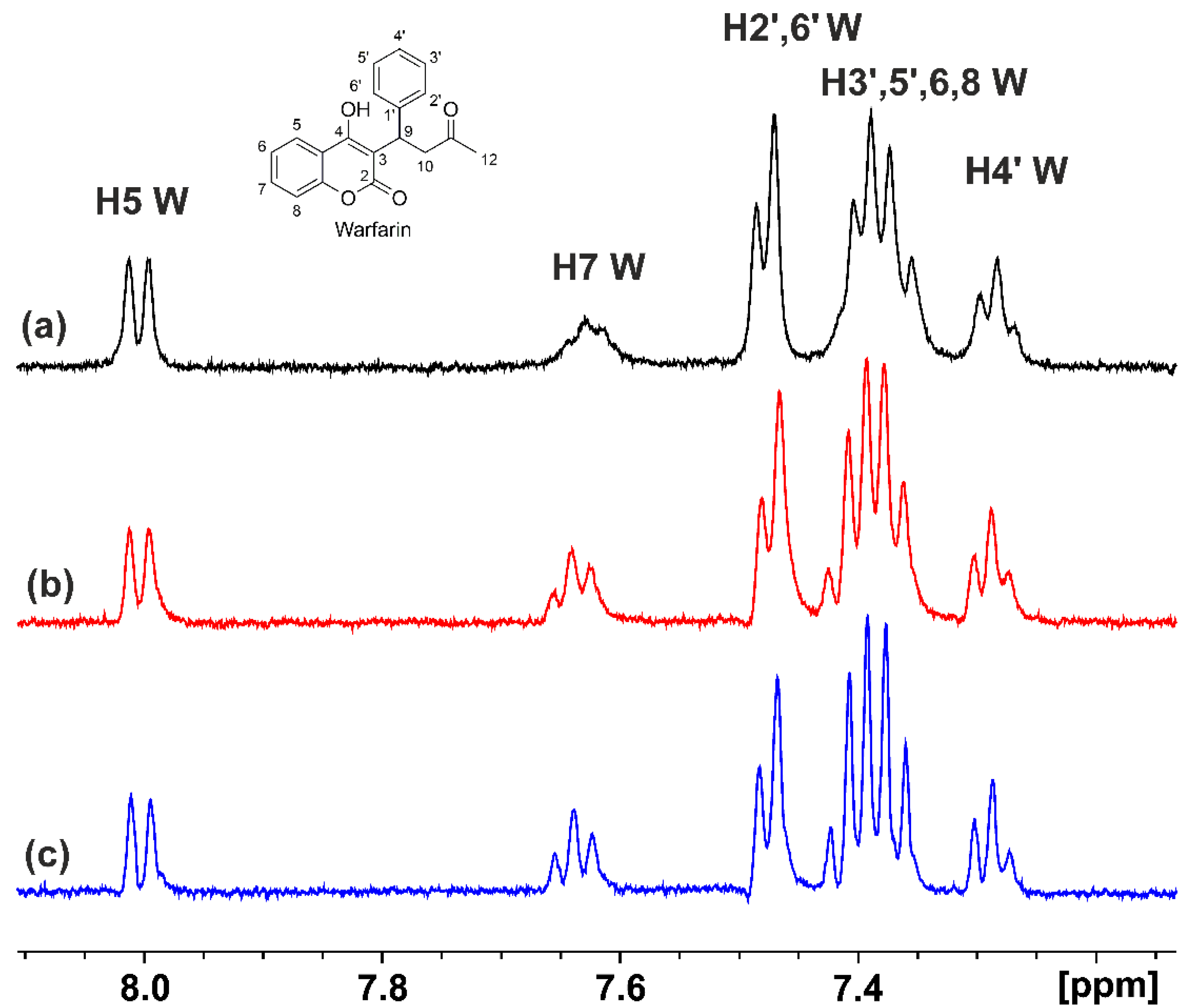
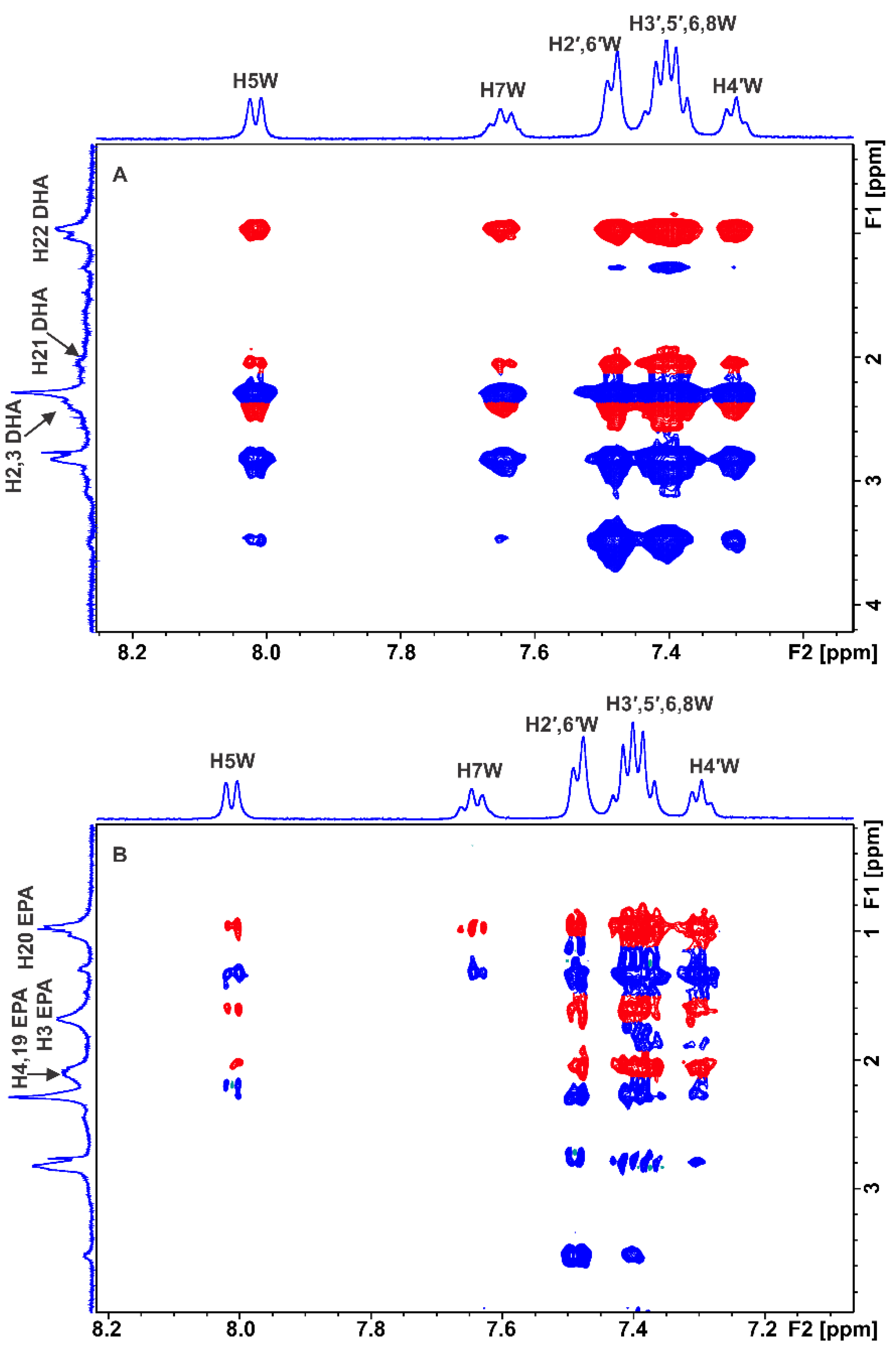
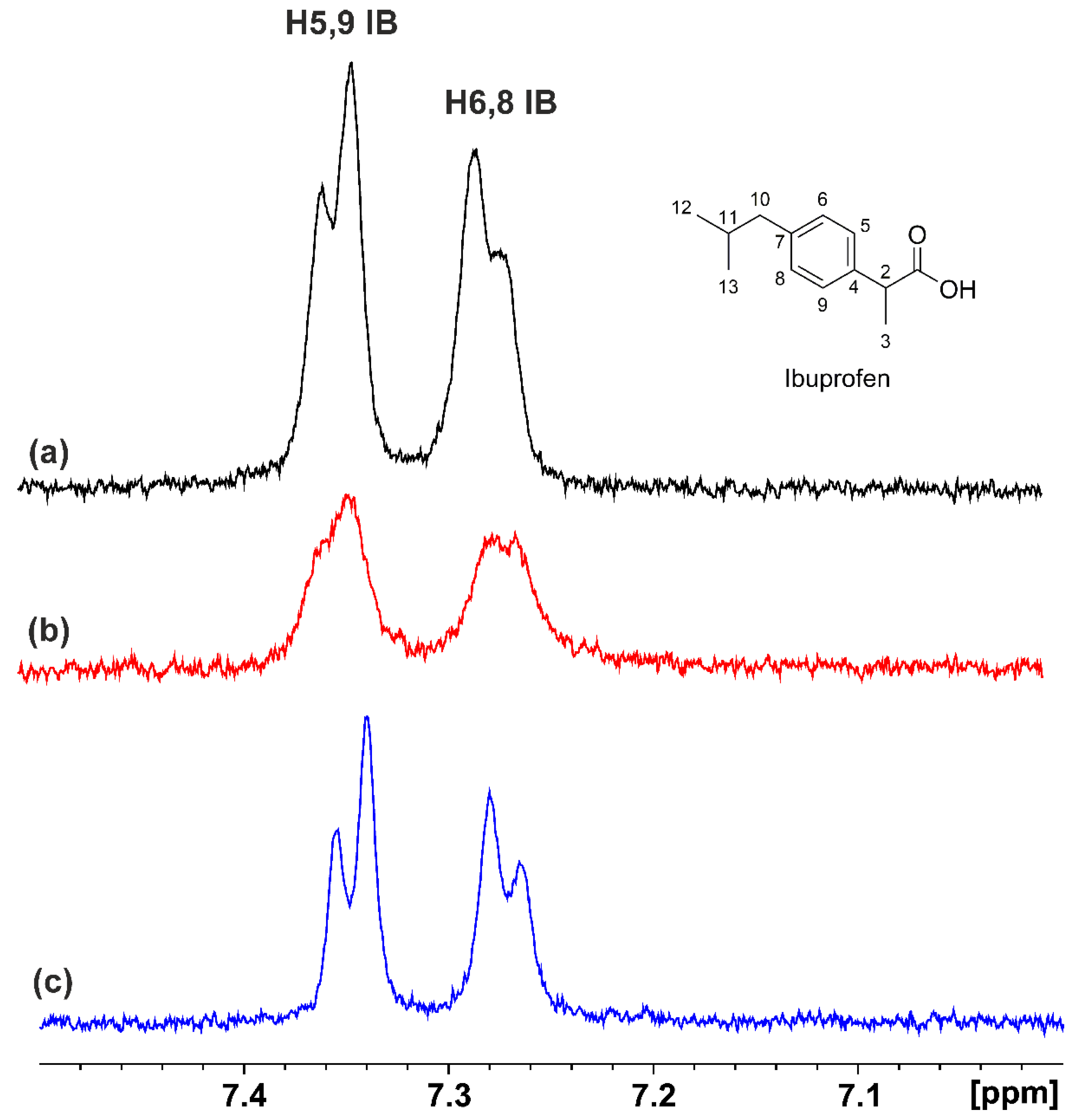
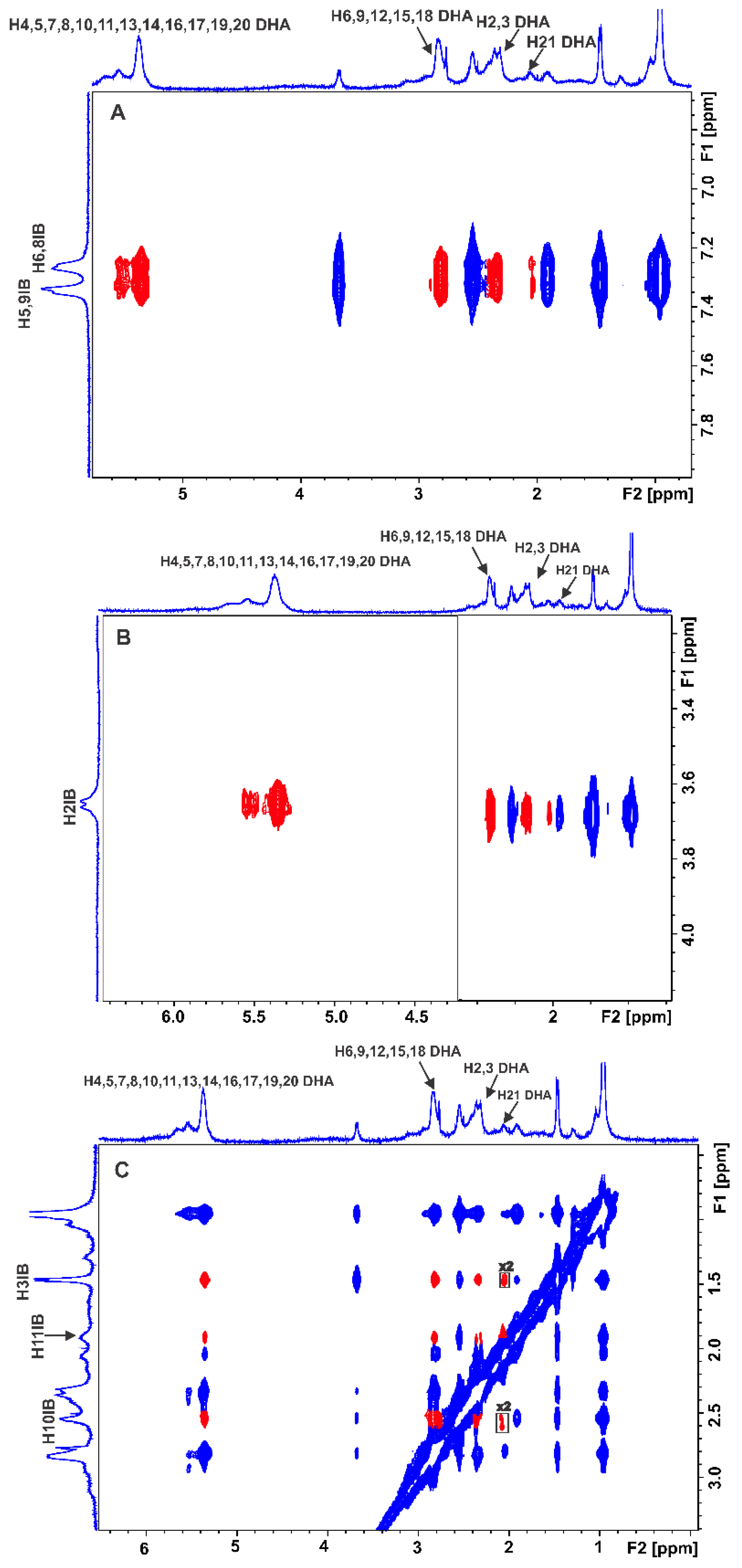
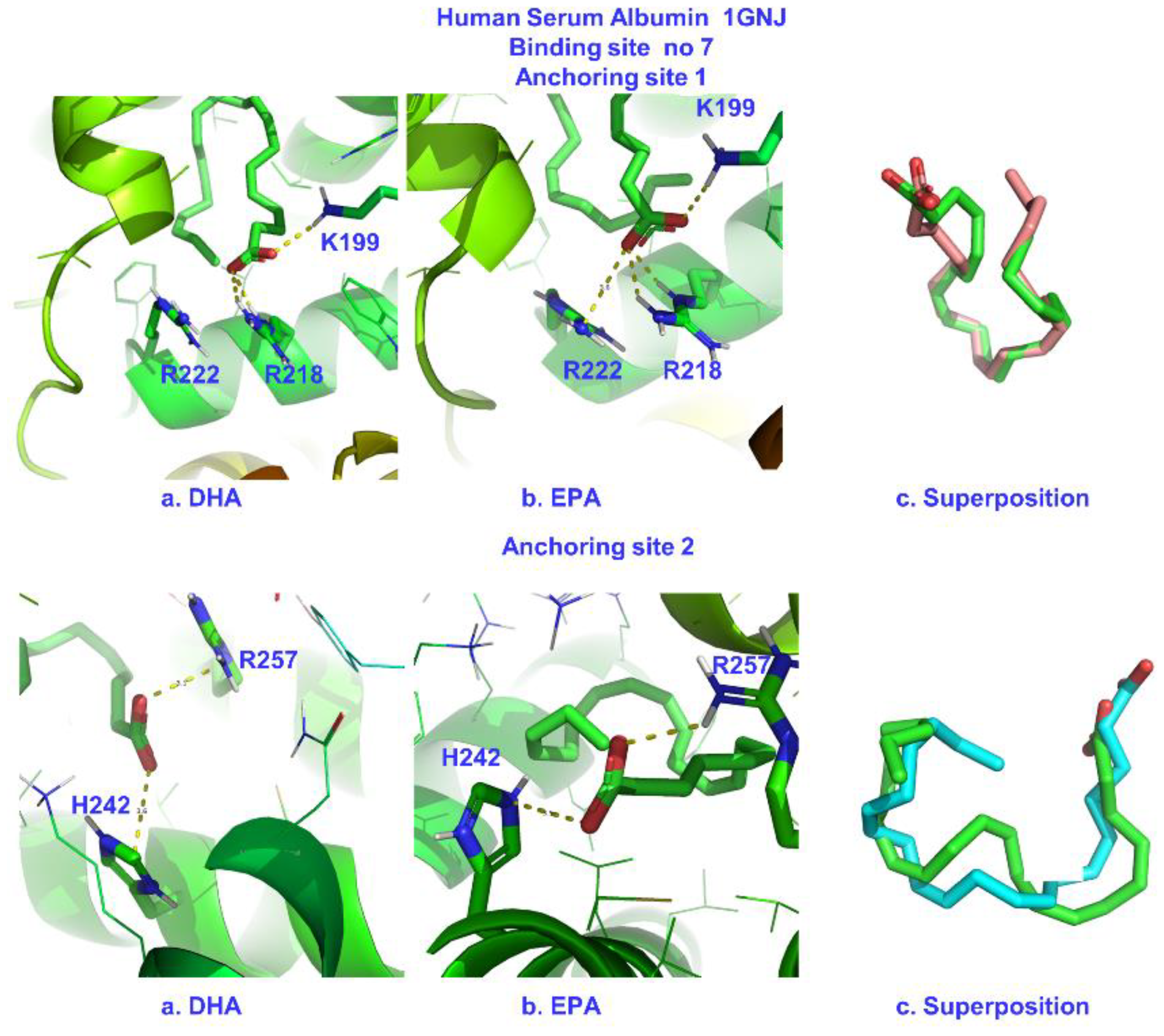

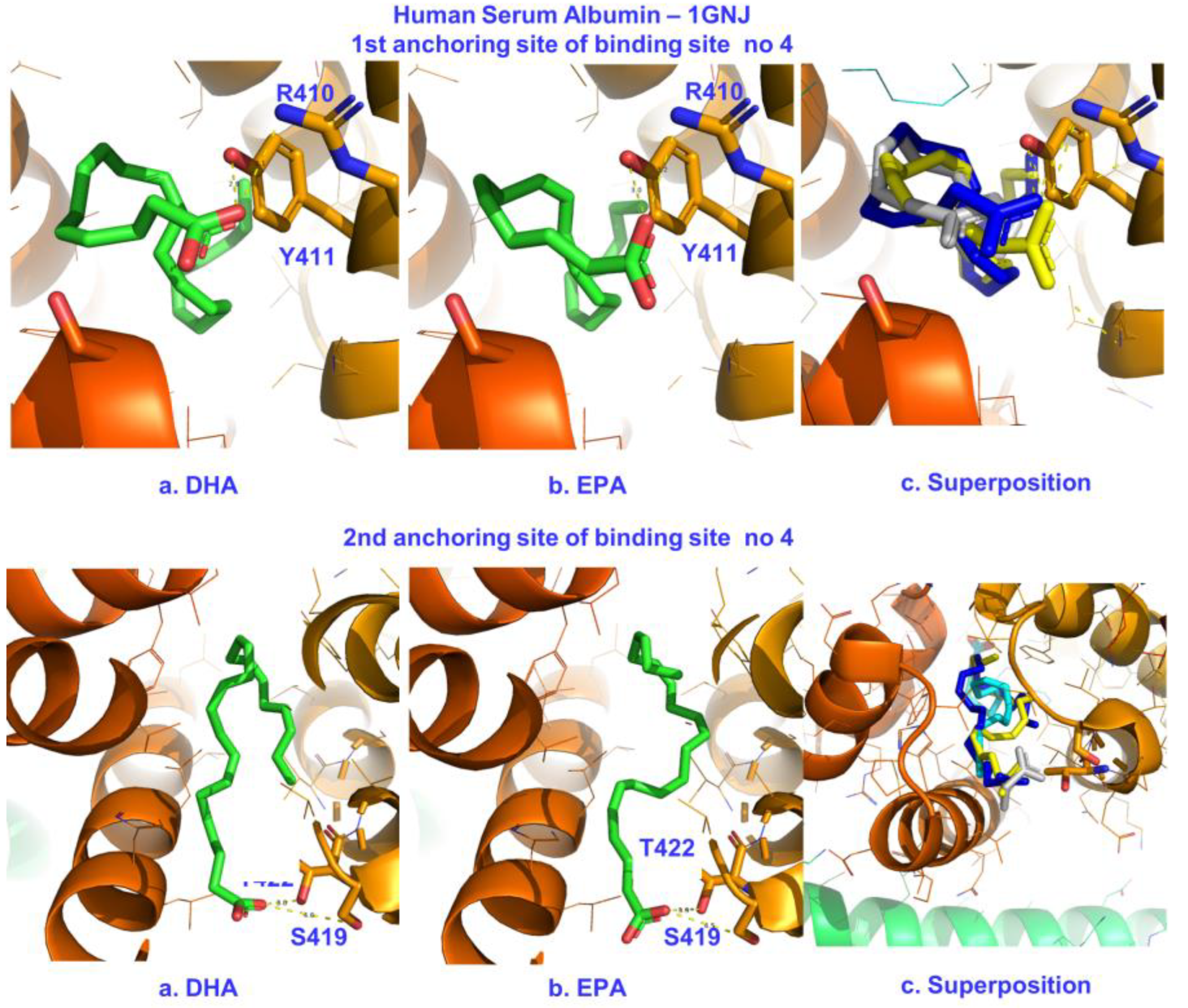


| Ligand | K199 | R218 | R222 | H242 | R257 | ||||||||||
|---|---|---|---|---|---|---|---|---|---|---|---|---|---|---|---|
| Anchor Site One | Anchor Site Two | ||||||||||||||
| Group | Dist. (Å) | Pose/Affinity (kcal/mol) | Group | Dist. (Å) | Pose/Affinity (kcal/mol) | Group | Dist. (Å) | Pose/Affinity (kcal/mol) | Group | Dist. (Å) | Pose/Affinity (kcal/mol) | Group | Dist. (Å) | Pose/Affinity (kcal/mol) | |
| DHA | N ζ | 3.1 | 2/−7.0 | NH ε | 3.0 | 2/−7.0 | NH2 η1 | 3.6 | 2/−7.0 | N ε2 | 3.1 | 1/−7.0 | NH2 η1 | 3.1 | 1/−7.0 |
| EPA | N ζ | 3.3 | 2/−6.8 | NH ε | 3.0 | 2/−6.8 | NH2 η1 | 3.3 | 2/−6.8 | N ε2 | 3.5 | 7/−6.7 | NH2 η1 | 3.0 | 7/−6.7 |
| Ligand | R410 | Y411 | S419 | T422 | ||||||
|---|---|---|---|---|---|---|---|---|---|---|
| Group | Distance (Å) | Group | Distance (Å) | Pose/Affinity (kcal/mol) | Group | Distance (Å) | Group | Distance (Å) | Pose/Affinity (kcal/mol) | |
| Anchor Site One | Anchor Site Two | |||||||||
| DHA | NH2 η2 | 3.1 | OH | 2.8 | 3/−7.5 | OH | 4.6 | OH | 3.0 | 2/−7.8 |
| EPA | NH2 η2 | 3.2 | OH | 3.0 | 3/−7.0 | OH | 4.5 | OH | 3.9 | 2/−7.8 |
| Ligands | S342 | R348 | R485 | ||||
|---|---|---|---|---|---|---|---|
| Group | Distance (Å) | Group | Distance (Å) | Group | Distance (Å) | Pose/Affinity (kcal/mol) | |
| DHA | OH | 3.0 | NH2 η2 | 3.0 | NH ε | 3.1 | 1/−8.3 |
| EPA | OH | 2.7 | NH2 η2 | 3.0 | NH ε | 3.0 | 1/−7.9 |
| Ligands | R209 | ||
|---|---|---|---|
| Group | Distance (Å) | Pose/Affinity (kcal/mol) | |
| DHA | NH ε | 3.1 | 5/−7.0 |
| EPA | NH2 η1 | 3.1 | 6/−6.9 |
Disclaimer/Publisher’s Note: The statements, opinions and data contained in all publications are solely those of the individual author(s) and contributor(s) and not of MDPI and/or the editor(s). MDPI and/or the editor(s) disclaim responsibility for any injury to people or property resulting from any ideas, methods, instructions or products referred to in the content. |
© 2023 by the authors. Licensee MDPI, Basel, Switzerland. This article is an open access article distributed under the terms and conditions of the Creative Commons Attribution (CC BY) license (https://creativecommons.org/licenses/by/4.0/).
Share and Cite
Alexandri, E.; Venianakis, T.; Primikyri, A.; Papamokos, G.; Gerothanassis, I.P. Molecular Basis for the Selectivity of DHA and EPA in Sudlow’s Drug Binding Sites in Human Serum Albumin with the Combined Use of NMR and Docking Calculations. Molecules 2023, 28, 3724. https://doi.org/10.3390/molecules28093724
Alexandri E, Venianakis T, Primikyri A, Papamokos G, Gerothanassis IP. Molecular Basis for the Selectivity of DHA and EPA in Sudlow’s Drug Binding Sites in Human Serum Albumin with the Combined Use of NMR and Docking Calculations. Molecules. 2023; 28(9):3724. https://doi.org/10.3390/molecules28093724
Chicago/Turabian StyleAlexandri, Eleni, Themistoklis Venianakis, Alexandra Primikyri, Georgios Papamokos, and Ioannis P. Gerothanassis. 2023. "Molecular Basis for the Selectivity of DHA and EPA in Sudlow’s Drug Binding Sites in Human Serum Albumin with the Combined Use of NMR and Docking Calculations" Molecules 28, no. 9: 3724. https://doi.org/10.3390/molecules28093724
APA StyleAlexandri, E., Venianakis, T., Primikyri, A., Papamokos, G., & Gerothanassis, I. P. (2023). Molecular Basis for the Selectivity of DHA and EPA in Sudlow’s Drug Binding Sites in Human Serum Albumin with the Combined Use of NMR and Docking Calculations. Molecules, 28(9), 3724. https://doi.org/10.3390/molecules28093724







